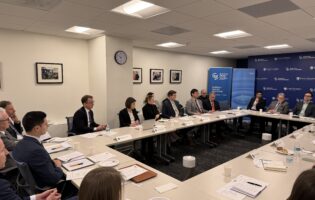Recovery or “Secular Stagnation”: The Outlook of the U.S. Economy
“Secular stagnation” is a term coined to describe long-term low levels of economic growth, blamed on inadequate capital investment in a country. The U.S. economy is teetering delicately between this state of secular stagnation, which could lead to another financial bubble, and a low but steadily increasing rate of growth. While the U.S. economy today is still below pre-crisis levels of growth, its recovery is underway, which also has a positive effect on Europe. Bernd Weidensteiner, Director and Senior U.S. Economist at Commerzbank AG, led a roundtable discussion at AGI on the outlook of the economy.
The main trend noticed in the U.S. economy is positive levels of overall growth in the manufacturing sector. Workers are putting in more hours of production and the sector has increased its global competitiveness, especially in terms of labor costs. This is partly a result of the growing fracking industry and efforts at energy independence. We can expect to see more jobs opening up in the manufacturing sector, and its economic capacity will continue to rise. This sector currently accounts for 10-12 percent of the total U.S. economy, which is a normal level for an advanced economy. The growing manufacturing industry is expected to also have positive effects on the service industry.
The high-tech industry is doing very well, mostly because of the auto industry and government intervention. Some economists like Larry Summers believe that the government should continue to pump money into the economy to encourage this type of growth, otherwise growth will remain stagnant.
GDP per capita is steadily growing, despite a drop in 2005-2007, and post-2009 growth has been at a steady 1.5 percent growth rate. We must be wary of a potential new financial bubble because of housing prices and Federal Reserve intervention. If this happened, housing prices will decline even more, and unemployment rates would soar. We are already seeing this result in Nevada after 2007.
Drivers of long-term growth in the U.S. are a mixture of demographics and productivity. The Federal Reserve must be careful not to artificially increase or decrease interest rates, which could hurt the natural growth pattern, and most likely would not be able to prevent a bubble by itself. It is expected that more public investment will not only pump life into the economy but encourage private investment.
The U.S. recovery is underway but most likely will take a long time before reaching pre-crisis levels of growth. However, there has already been a significant change in confidence that will have effects even across the Atlantic.
Please contact Kimberly Frank with any questions at kfrank@aicgs.org.
DATE: Monday, May 12, 2014
TIME: 10:30 – 12:00pm
LOCATION: AGI, Suite 700, R.G. Livingston Conference Room, 1755 Massachusetts Avenue, NW, Washington, DC 20036







